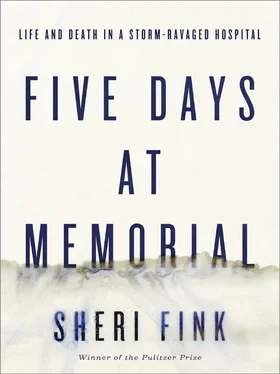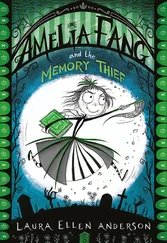At just after six in the morning, Katrina’s eye slid over land as a Category Three hurricane, glancing at New Orleans from Buras, Louisiana, about sixty miles southeast of the city. The storm raged after daybreak. The view outside Memorial, for those who dared to get close enough to a window to look, was an impenetrable white blanket. Gusts of 135 miles per hour were expected by nine thirty.
Between squalls it was possible to stand outside on the emergency room ramp and peek out from behind a heavy post. The US and Louisiana flags flapped madly on their flagpoles against a gray sky. Water raced like a river down Clara Street. A red car and a red van were bathed to the middle of their wheel wells. The wind kicked up whitecaps and spray.
The basement began taking water. It was, as it had been in 1926, full of food—three to five days’ worth, five to seven if it was rationed. Incident commander Mulderick helped pack the supplies onto rolling dollies and move them upstairs, an arduous process that took hours because of the limited number of hand trucks.
The possibility that the floodwaters could reach the first floor raised fears for the ten patients in the emergency room and the Noah’s ark of pets in the medical records department. For now, the emergency patients stayed put. Surgeon Anna Pou joined a chain of hospital volunteers and National Guard soldiers to help pass kennels up a staircase to the eighth floor and place them in the old, unused surgical suites behind the ICU. The area filled up with cages and the earsplitting barking and the stench of frightened animals.
Mulderick’s first-floor command center was relocated to a fourth-floor nurse training room. Another concern was drug reserves. Memorial, like many modern hospitals, did not maintain a large supply of medications on hand, opting instead for a “just in time delivery” system. The head pharmacist had requested an emergency cache of medicines from supplier McKesson on Saturday, but the company’s workers seemed to have already left their local warehouse ahead of the storm. They never delivered the drugs. Now, Monday morning, only about a day’s worth of certain medicines remained. Memorial would need more supplies by Tuesday morning.
Memorial CEO René Goux was on-site and asked his community relations manager, Sandra Cordray, to share these issues with corporate executives at Tenet Healthcare in Dallas. “Rene’s major concern is patient care after storm and high flood waters and continued loss of power,” she wrote in an e-mail to Tenet’s chief operating officer and other officials. “We will consider options for patient evacuation—that we may not have to use.”
Some patients were not being seen because their doctors were off-site and unreachable by phone. The medical staff president, Reuben L. Chrestman III, was on vacation. In his absence, Dr. Richard E. Deichmann, chairman of medical services, one of Memorial’s three clinical departments, took the lead in organizing the physicians. Most of them were, like Anna Pou, university doctors or private contractors credentialed to admit patients, but not employed by the hospital. Memorial didn’t specifically require most medical specialists to be present for hurricanes. These doctors had stayed either because they were on call for the weekend like Pou or had, like Dr. John Thiele, grown accustomed over years of hurricane warnings and near misses to spending storms in their offices.
More doctors seemed to be on hand than in any previous hurricane, perhaps because the storm had fallen on a weekend and those on call had simply stayed. Several, Deichmann and Baltz among them, were internists. Thiele was one of three lung specialists present who treated critically ill patients in the ICU. Others included a kidney specialist, an infectious diseases doctor, emergency medicine doctors, and neonatologists who took care of the youngest, sickest babies. There were several surgeons, including Pou, and three anesthesiologists. Deichmann assigned these clinical doctors to different nursing stations so that someone would be in charge of each of the fifteen patient units.
Katrina rapidly lost strength after moving onto land. The rain lessened and the winds began to ease by late morning. The water level outside Memorial stabilized at about three feet. Maintenance crews began to survey roof damage and broken windows, downed ceiling tiles, and sodden carpets that, in the growing heat, invited mold.
By midafternoon, the waters outside began to recede. Pets and food were carried back downstairs. Nurses mopped floors for hours until the rain and the ceiling leaks stopped completely. Patients tried to call loved ones to check on them and let them know they had come through all right. Emmett Everett, the 380-pound patient up in LifeCare who had been moved from Chalmette in St. Bernard Parish, was unable to reach his wife on her cell phone and told his nurse he was worried about her.
By evening, the flooding was gone, and it was possible to walk dogs outside. Some doctors who lived nearby navigated the debris-filled streets to check on their property and even stay the night at home. Other staff crossed back to their campsites in the new surgery building. Katrina had weakened before arrival, buffeting the city with only Category One or Two winds, not the Category Five tempests envisioned by the doom-prophesying weathermen. “We dodged a bullet,” people said to one another with weary relief. Memorial had sustained damage but remained functional on backup power. The hospital seemed to have weathered one more storm.

CHAPTER 4
DAY THREE
TUESDAY, AUGUST 30, 2005
“CODE BLUE, ER.”
Karen Wynn’s eyes opened in the dark room. She felt around for her shoes and socks, but could only find her teenage daughter’s flip-flops. She shoved them on her feet and ran the length of two city blocks from the new surgery building over the footbridge into the main hospital and down to the first-floor emergency room, struggling not to trip or cut her feet on broken glass.
Along the way, the ICU nurse manager tried to sort through her confusion. It had to be four or five in the morning. Why were they summoning her to a Code Blue in the emergency room? The ER staff members could resuscitate patients by themselves. Besides, who would be coming into the hospital when most of the city had been evacuated?
She arrived, panting. Blood was everywhere. A woman was lying on a gurney. She looked to be in her late sixties. The story came from her grandson, who had carried her up the ER ramp. There had been drinking. A fight. The woman’s daughter stabbed her in the chest with a kitchen knife. The grandson ran for help and found policemen, but they told him there were no ambulances running and he would have to find some other way to get her to the hospital.
The knife-and-gun club hadn’t taken a break, even within hours of a major hurricane.
The page operator called overhead for all doctors to come to the emergency room. Internist Horace Baltz appeared in a white coat, with bare legs. In an effort to get there quickly, the senior doctor had thrown the coat on over his shorts, then tied on his black Oxford shoes and run downstairs.
The patient, at first conscious and communicative, began struggling to breathe. Wynn knew air might have followed the knife’s path into her chest and collapsed her lungs. The woman’s blood-pressure measurements were falling.
Blood could be collecting in the sac around her heart, constricting it and limiting its ability to fill and pump. Someone called for an ultrasound machine technician to check this, but for now there was no time to await answers. A doctor made a cut in the skin between two of the woman’s ribs, spread the tissues with a blunt instrument, and pushed a tube into her chest cavity to release any built-up air. Another tube went into her throat and was attached to a mechanical ventilator to help her breathe.
Читать дальше













